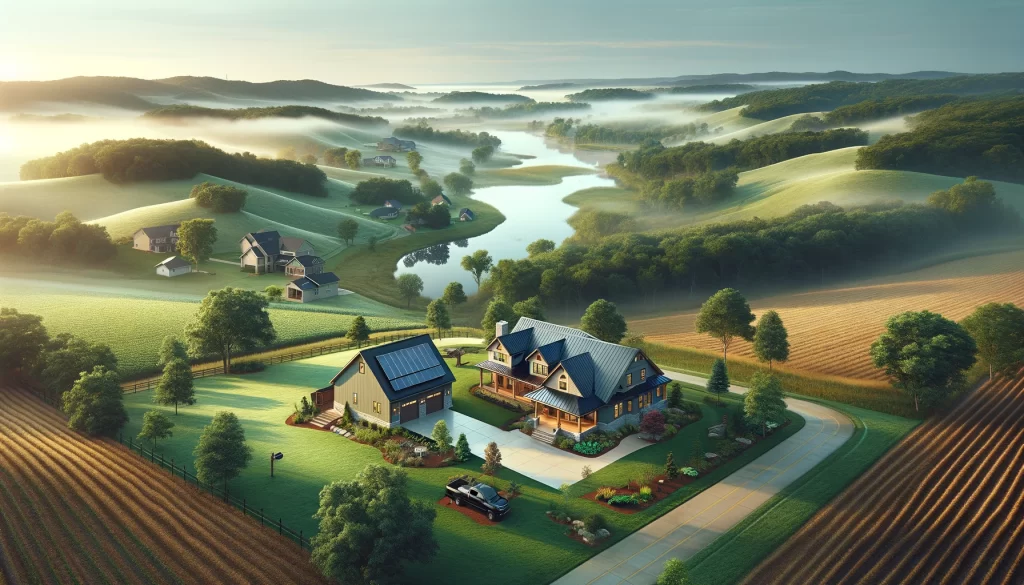Metal roofing is not just a durable solution for modern construction but also a beacon of energy efficiency and sustainability. The recent innovations in this field are shaping a future where roofs are integral to the energy conservation of buildings and the generation of clean energy.

Enhanced Insulation and Ventilation
The concept of insulation in metal roofing has evolved beyond simply keeping heat out or in. It now encompasses a holistic approach that aims at optimizing the building’s overall energy performance. Insulation technology for metal roofs has seen remarkable advancements, with materials that offer high R-values — a measure of insulation’s ability to resist heat flow — becoming increasingly standard. These materials are engineered to reduce heat transfer, helping maintain a stable interior temperature regardless of external weather conditions.
Ventilation is the other half of this energy efficiency equation. Proper ventilation is crucial in preventing heat accumulation during the summer and reducing condensation during colder months, which can lead to moisture-related issues such as mold growth or structural damage. The latest ventilation systems are designed to work in tandem with insulated metal roofs, ensuring a continuous flow of air through the attic space. This not only helps in regulating temperature but also contributes to the roof’s longevity by preventing the buildup of damp, stagnant air.
Furthermore, innovations such as above-sheathing ventilation (ASV) systems represent a significant leap forward. These systems create a ventilated airspace between the metal roof panel and the substrate. By doing so, they further enhance the roof’s thermal performance, leading to even greater energy savings. The ASV works by allowing outside air to enter through a perforated eave or ridge vent, flow underneath the roofing panels, and exit through ridge vents, effectively pulling heat away from the attic space and reducing the cooling load on the building.
By integrating these enhanced insulation and ventilation techniques, metal roofing is at the forefront of energy-efficient building design. These systems not only improve the comfort of occupants but also contribute to reducing the overall environmental impact of the building by lowering the demand for heating and cooling energy. This marriage of functionality and sustainability positions metal roofing as a smart choice for those looking to invest in a greener future.
Solar Panel Integration
The harmonious integration of solar panels into metal roofing represents a significant stride in the field of sustainable construction. Metal roofs offer an ideal platform for the installation of photovoltaic (PV) systems due to their durability and long lifespan, which typically matches or exceeds that of solar panels. This compatibility ensures that the roof can support the solar system throughout its entire operational period, making metal roofing a prudent choice for those considering renewable energy solutions.
Advances in solar technology have led to the creation of solar panels that can be seamlessly integrated into metal roofs, maintaining the roof’s aesthetic appeal. These solar-integrated metal roofs are designed to be low-profile, which mitigates any concerns homeowners might have regarding the appearance of traditional solar panels. Furthermore, the integration process has been simplified over the years, with solar panels that can be directly installed onto standing seam metal roofs without the need for additional racking systems. This not only reduces installation time and cost but also minimizes the number of penetrations in the roof, thereby preserving its integrity and watertightness.
Solar panel integration into metal roofing goes beyond mere installation. It includes electrical integration with the building’s power system and potentially the local grid, offering a dual benefit: it reduces reliance on external energy sources and can provide energy back to the grid, particularly during peak production times. This capability not only offers potential savings on energy bills but also supports the grid during high-demand periods, demonstrating the role individual buildings can play in the broader energy ecosystem.
The environmental benefits of solar-integrated metal roofing are clear and substantial. By reducing dependency on fossil fuels and lowering greenhouse gas emissions, these roofing systems contribute to a cleaner and more sustainable environment. They exemplify how modern building materials and renewable energy technologies can be integrated to create structures that are not only energy-efficient but also energy producers, marking a pivotal development towards achieving net-zero energy building standards.
The Combined Impact on Energy Consumption
The collective enhancements in insulation, ventilation, and solar panel integration in metal roofing create a synergistic effect that significantly lowers a building’s energy consumption. The insulation serves as a barrier against heat transfer, keeping interiors cool during summer and warm in winter, thereby reducing the need for air conditioning and heating. This energy conservation is crucial in the face of rising energy costs and environmental concerns.
When paired with effective ventilation, metal roofs prevent heat buildup and moisture accumulation, two factors that can increase energy usage if not managed properly. Ventilation ensures a continuous exchange of air, helping to naturally regulate the temperature of the attic and, by extension, the entire building. This process reduces the workload on HVAC systems, leading to energy savings and a more comfortable living environment.
Integrating solar panels into this mix transforms metal roofs from passive energy savers to active energy producers. By generating electricity, these solar systems can offset a significant portion, if not all, of the building’s electrical needs. On sunny days, excess energy can even be returned to the power grid, potentially earning credits for the building owner and contributing to the community’s energy needs.
The comprehensive approach to energy efficiency in metal roofing aligns with sustainable building practices and green certifications, like LEED and ENERGY STAR. This holistic view of energy consumption in the building process places metal roofing at the forefront of eco-friendly design and construction. The combined impact on energy consumption is clear: metal roofs with integrated solar panels and optimized insulation and ventilation can lead to substantial energy savings and a reduced carbon footprint, making them a smart choice for an energy-conscious future.

Sustainable Material Use
Sustainable material use is a cornerstone in the design and manufacture of metal roofing, reinforcing the industry’s commitment to environmental responsibility. Metal roofs are often composed of recycled materials, and this recyclability is maintained through the end of their life cycle, marking a stark contrast to traditional roofing materials which may contribute significantly to landfill waste.
The metals used in roofing, such as steel, aluminum, and copper, can be recycled repeatedly without loss of quality or performance. This cycle of reuse positions metal roofing within the circular economy, minimizing waste and the need for new raw materials. It’s estimated that steel roofing contains anywhere from 25% to 95% recycled content, and post-consumer aluminum roofing can be made of up to 95% recycled material.
By choosing metal roofing, consumers are not only selecting a durable and long-lasting product, but they are also making an environmentally conscious decision. The energy required to recycle these metals is a fraction of what is needed to produce new materials, further reducing the overall energy footprint associated with metal roofs.
Moreover, the longevity of metal roofing means fewer replacements over time, leading to less frequent material use and reduced resource depletion. Their durability also contributes to sustainability by withstanding extreme weather conditions, which reduces the frequency and extent of repairs and replacements.
In addition to their green manufacturing and end-of-life processing, the natural properties of metal roofs contribute to sustainable building practices. Their reflective surfaces help in reducing heat islands in urban areas, and their compatibility with rainwater harvesting systems supports sustainable water use practices.
As we continue to strive for more sustainable building solutions, metal roofing stands out as a choice that benefits not only the individual homeowner or business but also the wider community and the planet. This commitment to sustainable material use reflects the metal roofing industry’s broader role in promoting sustainable development and green building initiatives.
A Call to Action for the Future
The advancements in metal roofing technology present a call to action for the future of sustainable and energy-efficient construction. Homeowners, architects, and builders are encouraged to recognize the long-term benefits and potential of metal roofs in contributing to a greener world. As we face environmental challenges and seek to reduce our carbon footprint, the choices made in building materials become increasingly significant.
The integration of energy-efficient features, such as advanced insulation and ventilation, along with the incorporation of renewable energy technologies like solar panels, points to a future where our homes and businesses can be both protective shelters and active participants in energy conservation. By choosing metal roofing, we are not just investing in the longevity and durability of our structures but also in a sustainable future.
Building owners and decision-makers are urged to consider metal roofs as a practical and environmentally responsible option. The industry must continue to innovate, pushing the boundaries of what is possible with metal roofing. Governments and policymakers are also called upon to support these initiatives, through incentives and regulations that favor sustainable practices.
The future envisioned is one where metal roofing plays a pivotal role in energy-efficient building design, leading the way towards more sustainable living spaces. It’s an opportunity to contribute positively to the environment while also reaping the economic benefits of reduced energy costs. Embracing these advancements in metal roofing is not only a smart choice for today but an essential investment in the health and well-being of our planet for generations to come.
Frequently Asked Questions About Cook Roofing's Metal Solutions
Q: What are energy-efficient metal roofs?
A: Energy-efficient metal roofs are designed with reflective coatings and insulation to minimize heat absorption and improve a building’s thermal regulation, leading to lower energy costs.
Q: Can metal roofs be eco-friendly?
A: Yes, metal roofs are eco-friendly due to their high recyclability, long lifespan, and ability to incorporate sustainable features like solar panels.
Q: How do solar panels integrate with metal roofing?
A: Solar panels can be seamlessly integrated into metal roofing, often attached to standing seams without penetrating the roof, promoting clean energy generation.
Q: Do metal roofs contribute to sustainability?
A: Metal roofs contribute to sustainability by using recycled materials, reducing waste, and improving energy efficiency in homes and buildings.
Q: What materials are used in sustainable metal roofing?
A: Sustainable metal roofing typically uses steel, aluminum, and copper, often containing a high percentage of recycled content.
Q: Why choose metal roofing for energy conservation?
A: Metal roofing is ideal for energy conservation due to its ability to reflect heat, support solar energy systems, and enhance building insulation.
Q: How does metal roofing affect a building’s energy usage?
A: Metal roofing can significantly reduce a building’s energy usage by improving thermal performance and potentially generating renewable energy.
Q: Are there incentives for installing metal roofing with solar panels?
A: Yes, many regions offer incentives like tax credits and rebates for installing metal roofing with integrated solar panel systems.
Q: Can installing a metal roof lower energy bills?
A: Installing a metal roof can lower energy bills by reflecting sunlight and reducing the need for air conditioning during hot weather.
Q: Is metal roofing a good choice for green building certifications?
A: Metal roofing supports green building certifications like LEED, thanks to its energy efficiency and use of sustainable materials.
Q: How long do energy-efficient metal roofs last?
A: Energy-efficient metal roofs can last 40-70 years, offering a durable solution that complements a building’s sustainable design.
Q: What makes metal roofs ideal for severe weather regions?
A: Metal roofs are ideal for severe weather due to their strength, ability to withstand high winds, and resistance to fire and hail damage.

